15+ 5th anti money laundering directive cryptocurrency information
Home » money laundering Info » 15+ 5th anti money laundering directive cryptocurrency informationYour 5th anti money laundering directive cryptocurrency images are ready. 5th anti money laundering directive cryptocurrency are a topic that is being searched for and liked by netizens now. You can Download the 5th anti money laundering directive cryptocurrency files here. Find and Download all royalty-free photos.
If you’re looking for 5th anti money laundering directive cryptocurrency images information linked to the 5th anti money laundering directive cryptocurrency keyword, you have visit the right blog. Our site frequently provides you with hints for downloading the maximum quality video and image content, please kindly hunt and locate more informative video content and images that match your interests.
5th Anti Money Laundering Directive Cryptocurrency. The 5th Anti-Money Laundering Directive which amends the 4th Anti-Money Laundering Directive was published on June 19th 2018 as a result of the constantly changing financial situation of the market. 5MLD obliges Cryptoasset businesses to implement robust risk-based policies and procedures to comply with Anti-Money. The European Unions 5th Anti-Money Laundering Directive 5AMLD came into effect January 10. Progressively more regulators are including cryptocurrencies within their AML and financial services regulation and those who provide services directly and indirectly are coming into the.
 Anti Money Laundering And Cryptocurrencies Safe Or Too Risky To Touch Thepaypers From thepaypers.com
Anti Money Laundering And Cryptocurrencies Safe Or Too Risky To Touch Thepaypers From thepaypers.com
A legal definition of cryptocurrency which may broadly be regarded as a digital representation. The legislation known as the 5th Anti-Money Laundering Directive marks a key development in cryptocurrency regulation with the worlds second largest economy now providing clarity to cryptocurrency businesses on their anti-money laundering AML and counter-terrorism financing CTF obligations. The AMLD5 will burden small firms and force them to either merge or fold. The debate over whether regulation is a positive or negative thing for the cryptocurrency industry has evolved over the past two years as regulation has shifted from theory into practice. The European Unions 5th Anti-Money Laundering Directive mandates that member states start regulating crypto assets by Jan. In January 2020 the EUs fifth Anti-Money Laundering Directive 5MLD came into force expanding the sectors that will now become obliged entities to include Virtual Assets and Virtual Asset Service providers otherwise known as Cryptoasset businesses.
In more detail 5MLD introduces the following measures.
The debate over whether regulation is a positive or negative thing for the cryptocurrency industry has evolved over the past two years as regulation has shifted from theory into practice. 5AMLD 5th Anti-Money Laundering Directive. Some service providers connected to virtual currencies are made subject to anti-money laundering law. Although much of 5MLDs content updates the 4MLD it makes a significant new legislative step in the treatment of virtual currencies. The European Unions 5th Anti-Money Laundering Directive 5AMLD came into effect January 10. In more detail 5MLD introduces the following measures.
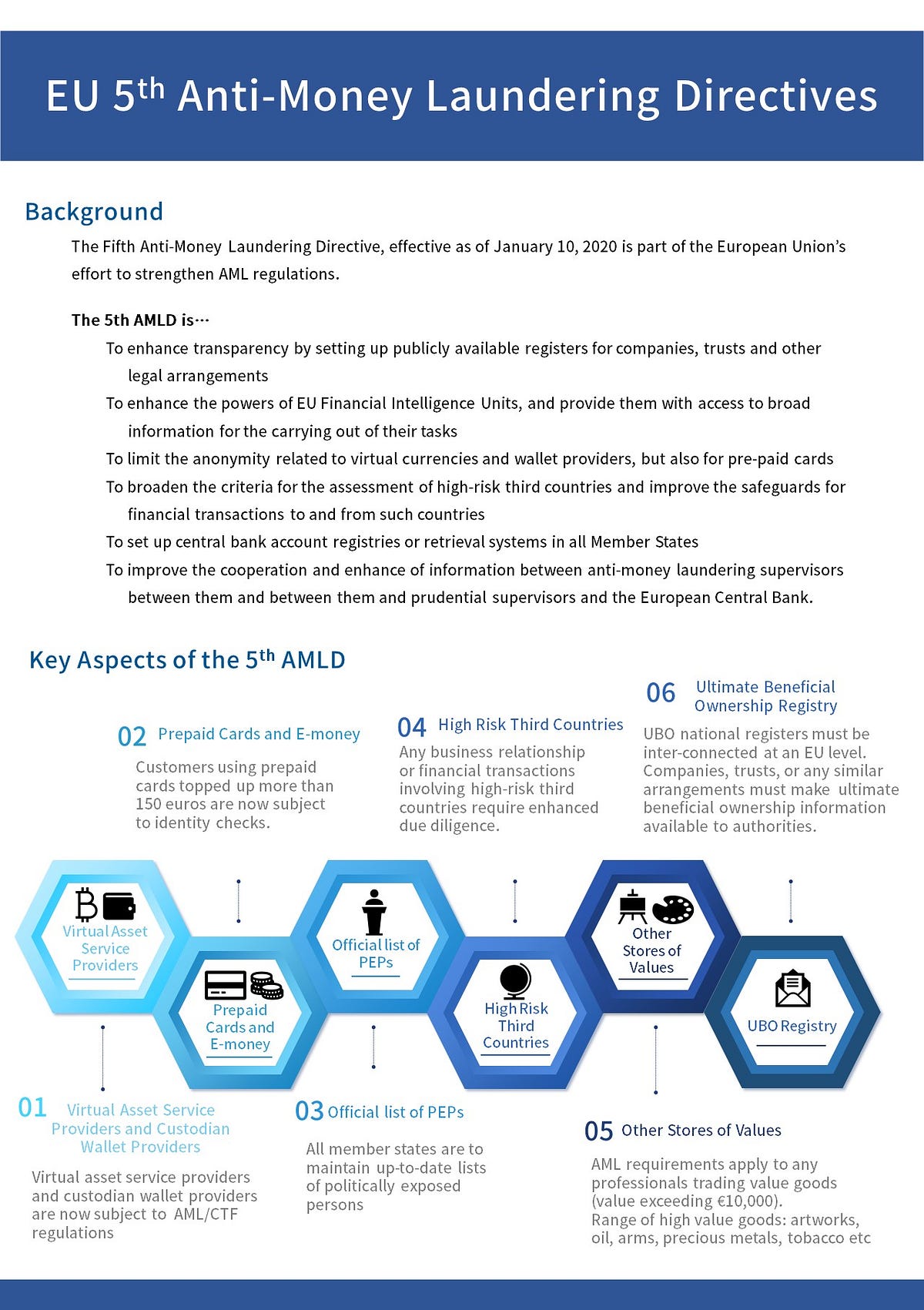 Source: argoskyc.medium.com
Source: argoskyc.medium.com
This will be the 5 th Anti-Money Laundering Directive AMLD5 and among others comes with a requirement for preventive responsibility by the crypto-currency market. 5MLD obliges Cryptoasset businesses to implement robust risk-based policies and procedures to comply with Anti-Money. The regulation was entered as law on July 9 2018 in an effort to bring increased transparency to financial transactions for pushing back against money laundering. Crypto exchanges and custodial wallet providers are now covered by the same regulatory requirements as banks and other financial institutions. Some service providers connected to virtual currencies are made subject to anti-money laundering law.
 Source: coinfirm.com
Source: coinfirm.com
The legislation known as the 5th Anti-Money Laundering Directive marks a key development in cryptocurrency regulation with the worlds second largest economy now providing clarity to cryptocurrency businesses on their anti-money laundering AML and counter-terrorism financing CTF obligations. Crypto exchanges and custodial wallet providers are now covered by the same regulatory requirements as banks and other financial institutions. The core aim of the 5MLD is to address modern-day money laundering concerns that were not covered in. In more detail 5MLD introduces the following measures. Directive EU 2018843 of the European Parliament and of the Council of 30 May 2018 amending Directive EU0 2015849 on the prevention of the use of the financial system for the purpose of money laundering or terrorist financing also commonly referred to as the 5th Anti-Money Laundering Directive 5AMLD of the European Union came into force on January 10 2020.
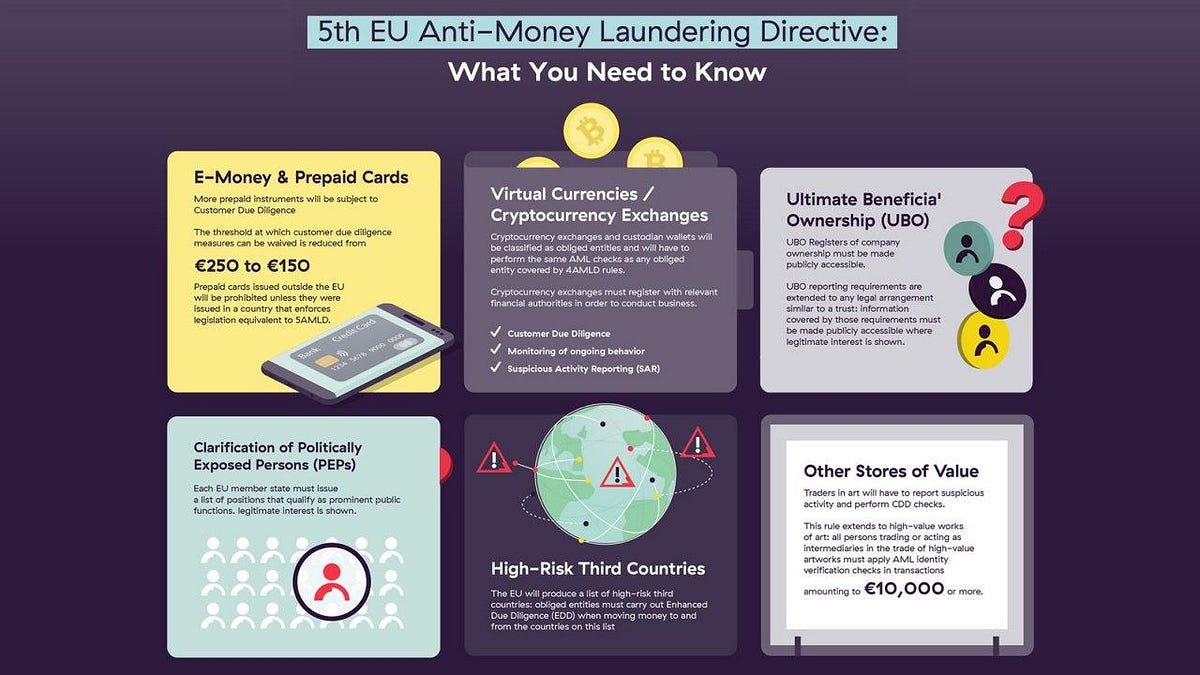 Source: medium.com
Source: medium.com
Progressively more regulators are including cryptocurrencies within their AML and financial services regulation and those who provide services directly and indirectly are coming into the. European cryptocurrency firms are expecting a stricter regime of regulations as the 28 EU states are preparing to adopt the 5th Anti-Money Laundering Directive AMLD5. 11th November 2019 The Fifth Money Laundering Directive is set to be transposed into national law by 10 January 2020. In Europe including the UK the 5th Anti-Money Laundering Directive brought cryptocurrencies into continent-wide AML requirements including the registration of VASPs with country regulators. Directive EU 2018843 of the European Parliament and of the Council of 30 May 2018 amending Directive EU0 2015849 on the prevention of the use of the financial system for the purpose of money laundering or terrorist financing also commonly referred to as the 5th Anti-Money Laundering Directive 5AMLD of the European Union came into force on January 10 2020.
 Source: coinfirm.com
Source: coinfirm.com
The core aim of the 5MLD is to address modern-day money laundering concerns that were not covered in. To fight these risks the European Parliament and the Council of the European Union has agreed to amend and expand existing anti-money laundering legislation. In more detail 5MLD introduces the following measures. The European Unions 5th Anti-Money Laundering Directive mandates that member states start regulating crypto assets by Jan. A legal definition of cryptocurrency which may broadly be regarded as a digital representation.
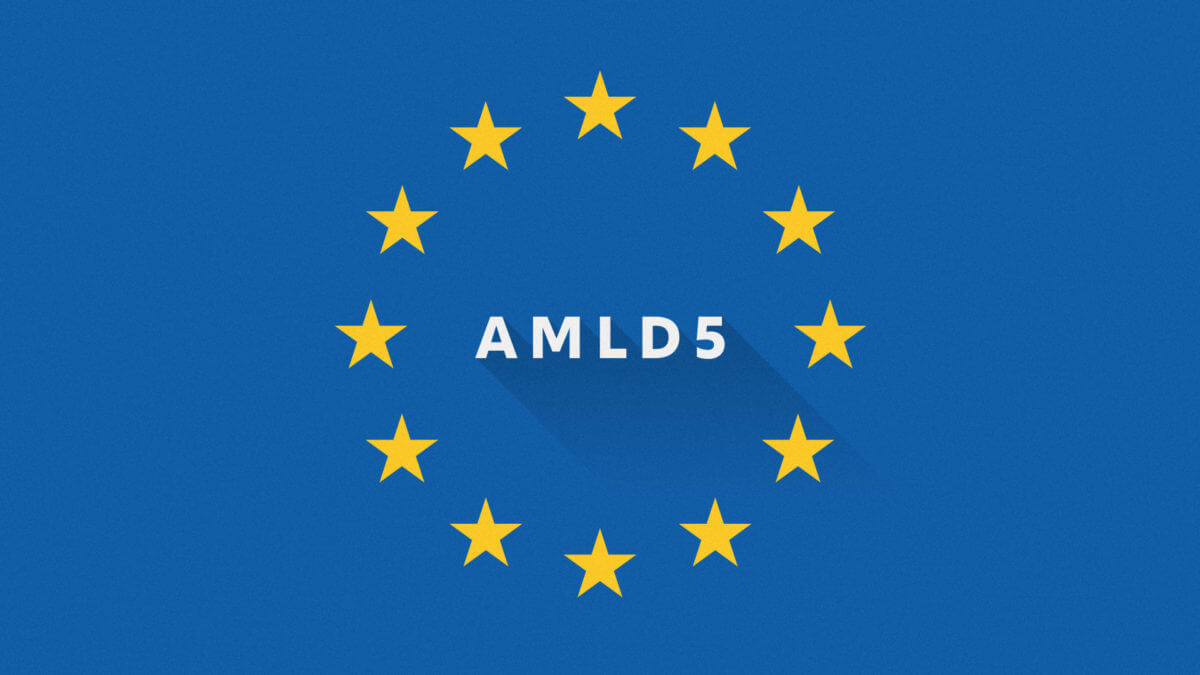 Source: iceclog.com
Source: iceclog.com
The AMLD5 will burden small firms and force them to either merge or fold. The core aim of the 5MLD is to address modern-day money laundering concerns that were not covered in. The European Unions 5th Anti-Money Laundering Directive 5AMLD came into effect January 10. The debate over whether regulation is a positive or negative thing for the cryptocurrency industry has evolved over the past two years as regulation has shifted from theory into practice. This will be the 5 th Anti-Money Laundering Directive AMLD5 and among others comes with a requirement for preventive responsibility by the crypto-currency market.
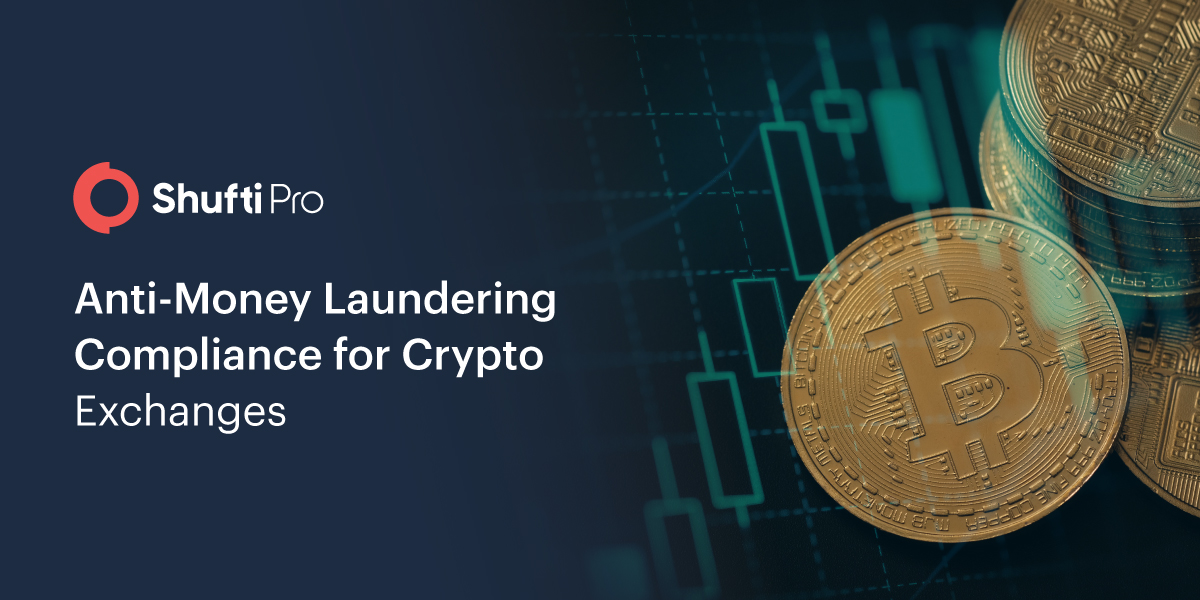 Source: shuftipro.com
Source: shuftipro.com
The AMLD5 will burden small firms and force them to either merge or fold. Crypto exchanges and custodial wallet providers are now covered by the same regulatory requirements as banks and other financial institutions. In Europe including the UK the 5th Anti-Money Laundering Directive brought cryptocurrencies into continent-wide AML requirements including the registration of VASPs with country regulators. FIFTHANTI-MONEY LAUNDERINGDIRECTIVEAMLD5 Directive EU 2018843 of the European Parliament and of the Council of 30 May 2018 amending Directive EU 2015849 on the prevention of the use of the financial system for the purposes of money laundering or terrorist financing and amending Directives 2009138EC and 201336EU. Cryptoasset businesses carrying on the activities listed below must comply with the MLRs since 10 January 2020.
 Source: integress.co.uk
Source: integress.co.uk
Although much of 5MLDs content updates the 4MLD it makes a significant new legislative step in the treatment of virtual currencies. Progressively more regulators are including cryptocurrencies within their AML and financial services regulation and those who provide services directly and indirectly are coming into the. Directive 2018843 better known as the 5th Anti-Money Laundering Directive fails however to address key technological breakthroughs and new business models which continuously make the evergrowing and fast-paced crypto economy evolve. The debate over whether regulation is a positive or negative thing for the cryptocurrency industry has evolved over the past two years as regulation has shifted from theory into practice. Crypto exchanges and custodial wallet providers are now covered by the same regulatory requirements as banks and other financial institutions.
 Source: thepaypers.com
Source: thepaypers.com
Fifth anti money laundering directive cryptocurrency Posted on August 3 2021 August 3 2021 by It seems that worth momentum does exist within the bitcoin market as price movements usually are not entirely independent of one another. Fifth anti money laundering directive cryptocurrency Posted on August 7 2021 by Theres a very high degree of risk concerned in buying and selling securities and this buying and selling threat is increased with Cryptocurrencies reminiscent of BCH because of markets being decentralized and non-regulated. Progressively more regulators are including cryptocurrencies within their AML and financial services regulation and those who provide services directly and indirectly are coming into the. How will the 5th Money Laundering Directive affect cryptocurrencies. The legislation known as the 5th Anti-Money Laundering Directive marks a key development in cryptocurrency regulation with the worlds second largest economy now providing clarity to cryptocurrency businesses on their anti-money laundering AML and counter-terrorism financing CTF obligations.
 Source: medium.com
Source: medium.com
The legislation known as the 5th Anti-Money Laundering Directive marks a key development in cryptocurrency regulation with the worlds second largest economy now providing clarity to cryptocurrency businesses on their anti-money laundering AML and counter-terrorism financing CTF obligations. In more detail 5MLD introduces the following measures. Fifth anti money laundering directive cryptocurrency Posted on August 3 2021 August 3 2021 by It seems that worth momentum does exist within the bitcoin market as price movements usually are not entirely independent of one another. The debate over whether regulation is a positive or negative thing for the cryptocurrency industry has evolved over the past two years as regulation has shifted from theory into practice. The core aim of the 5MLD is to address modern-day money laundering concerns that were not covered in.
 Source: researchgate.net
Source: researchgate.net
European cryptocurrency firms are expecting a stricter regime of regulations as the 28 EU states are preparing to adopt the 5th Anti-Money Laundering Directive AMLD5. Some service providers connected to virtual currencies are made subject to anti-money laundering law. Directive 2018843 better known as the 5th Anti-Money Laundering Directive fails however to address key technological breakthroughs and new business models which continuously make the evergrowing and fast-paced crypto economy evolve. The 5th Anti-Money Laundering Directive which amends the 4th Anti-Money Laundering Directive was published on June 19th 2018 as a result of the constantly changing financial situation of the market. Directive EU 2018843 the fifth anti-money laundering Directive intends to mitigate these risks by introducing a definition of virtual currencies within Union law.
 Source: complyadvantage.com
Source: complyadvantage.com
The debate over whether regulation is a positive or negative thing for the cryptocurrency industry has evolved over the past two years as regulation has shifted from theory into practice. 11th November 2019 The Fifth Money Laundering Directive is set to be transposed into national law by 10 January 2020. In January 2020 the EUs fifth Anti-Money Laundering Directive 5MLD came into force expanding the sectors that will now become obliged entities to include Virtual Assets and Virtual Asset Service providers otherwise known as Cryptoasset businesses. FIFTHANTI-MONEY LAUNDERINGDIRECTIVEAMLD5 Directive EU 2018843 of the European Parliament and of the Council of 30 May 2018 amending Directive EU 2015849 on the prevention of the use of the financial system for the purposes of money laundering or terrorist financing and amending Directives 2009138EC and 201336EU. Crypto exchanges and custodial wallet providers are now covered by the same regulatory requirements as banks and other financial institutions.
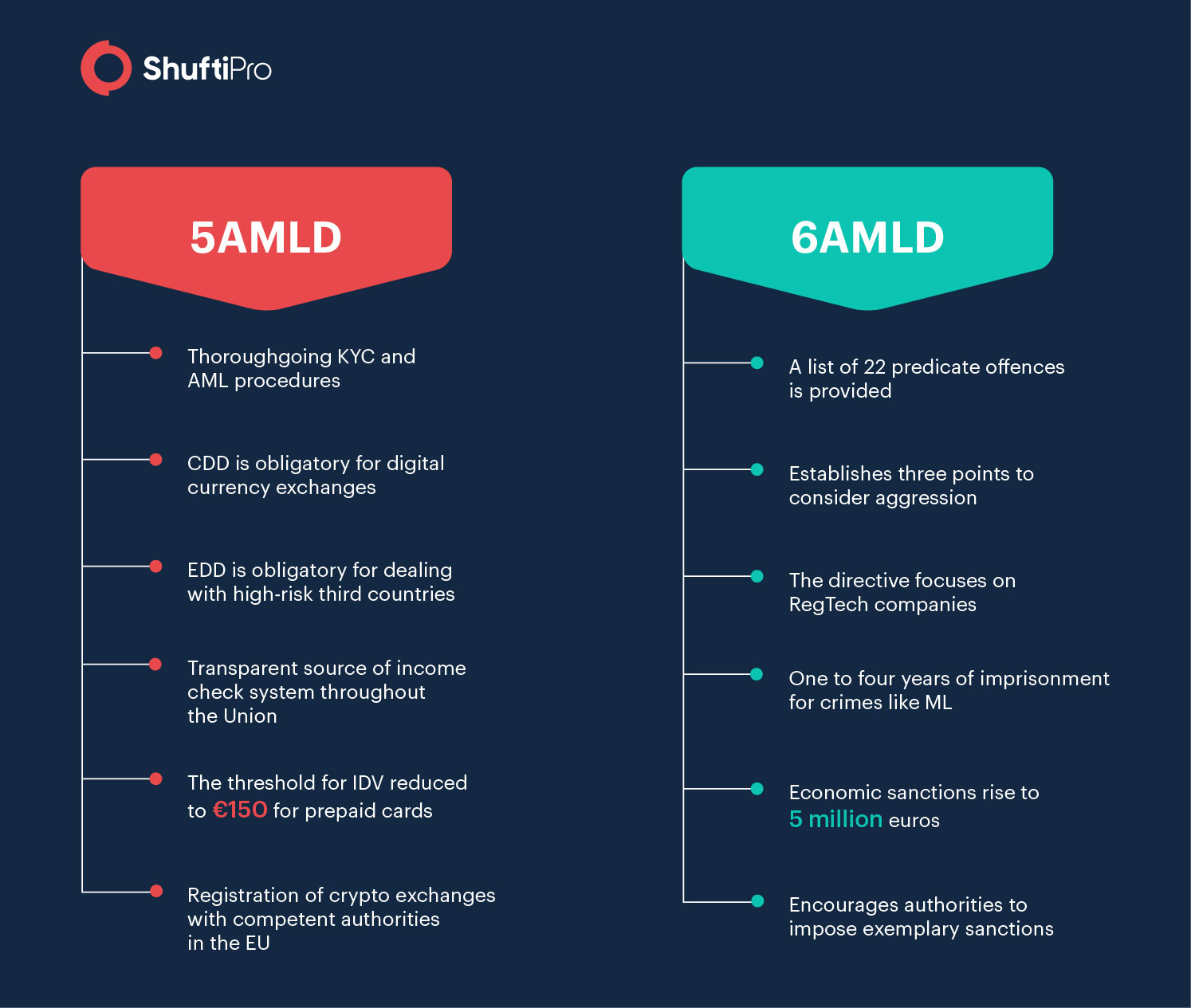 Source: shuftipro.com
Source: shuftipro.com
In more detail 5MLD introduces the following measures. In more detail 5MLD introduces the following measures. Some service providers connected to virtual currencies are made subject to anti-money laundering law. Directive EU 2018843 of the European Parliament and of the Council of 30 May 2018 amending Directive EU0 2015849 on the prevention of the use of the financial system for the purpose of money laundering or terrorist financing also commonly referred to as the 5th Anti-Money Laundering Directive 5AMLD of the European Union came into force on January 10 2020. Directive 2018843 better known as the 5th Anti-Money Laundering Directive fails however to address key technological breakthroughs and new business models which continuously make the evergrowing and fast-paced crypto economy evolve.
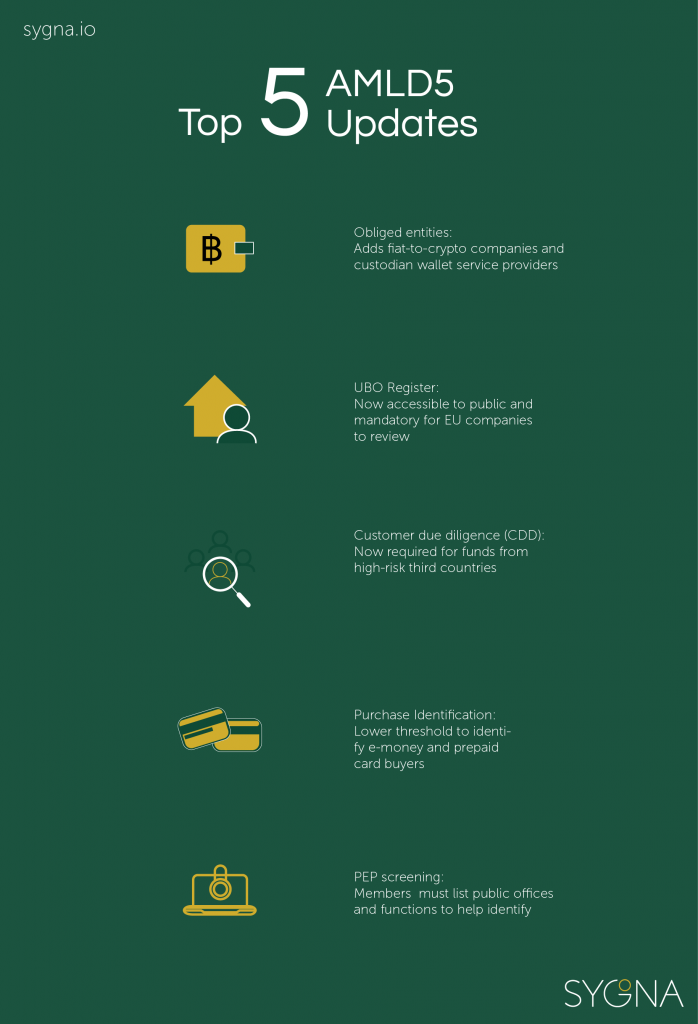 Source: sygna.io
Source: sygna.io
The Treasury has published the Statutory Instrument which covers the activities specified in the EUs 5th Money Laundering Directive 5MLD and a wider range of activities as recommended by the Financial Action Task Force FATF. All over the world the regulatory tide is rising. Directive EU 2018843 of the European Parliament and of the Council of 30 May 2018 amending Directive EU0 2015849 on the prevention of the use of the financial system for the purpose of money laundering or terrorist financing also commonly referred to as the 5th Anti-Money Laundering Directive 5AMLD of the European Union came into force on January 10 2020. In more detail 5MLD introduces the following measures. The European Unions 5th Anti-Money Laundering Directive mandates that member states start regulating crypto assets by Jan.
This site is an open community for users to submit their favorite wallpapers on the internet, all images or pictures in this website are for personal wallpaper use only, it is stricly prohibited to use this wallpaper for commercial purposes, if you are the author and find this image is shared without your permission, please kindly raise a DMCA report to Us.
If you find this site beneficial, please support us by sharing this posts to your favorite social media accounts like Facebook, Instagram and so on or you can also save this blog page with the title 5th anti money laundering directive cryptocurrency by using Ctrl + D for devices a laptop with a Windows operating system or Command + D for laptops with an Apple operating system. If you use a smartphone, you can also use the drawer menu of the browser you are using. Whether it’s a Windows, Mac, iOS or Android operating system, you will still be able to bookmark this website.
Category
Related By Category
- 19+ Aml definition finance ideas in 2021
- 17+ Bank negara malaysia nor shamsiah mohd yunus ideas in 2021
- 16++ How do you launder money by inflating expenses info
- 10+ Anti money laundering registration hmrc ideas
- 19++ Amld5 virtual currencies ideas
- 11++ How to apply for anti money laundering certificate information
- 20+ Anti money laundering for insurance agents ideas
- 10+ Currency and foreign transactions reporting act pdf ideas in 2021
- 13++ Commercial transactions exam notes info
- 14++ Explain term money laundering ideas